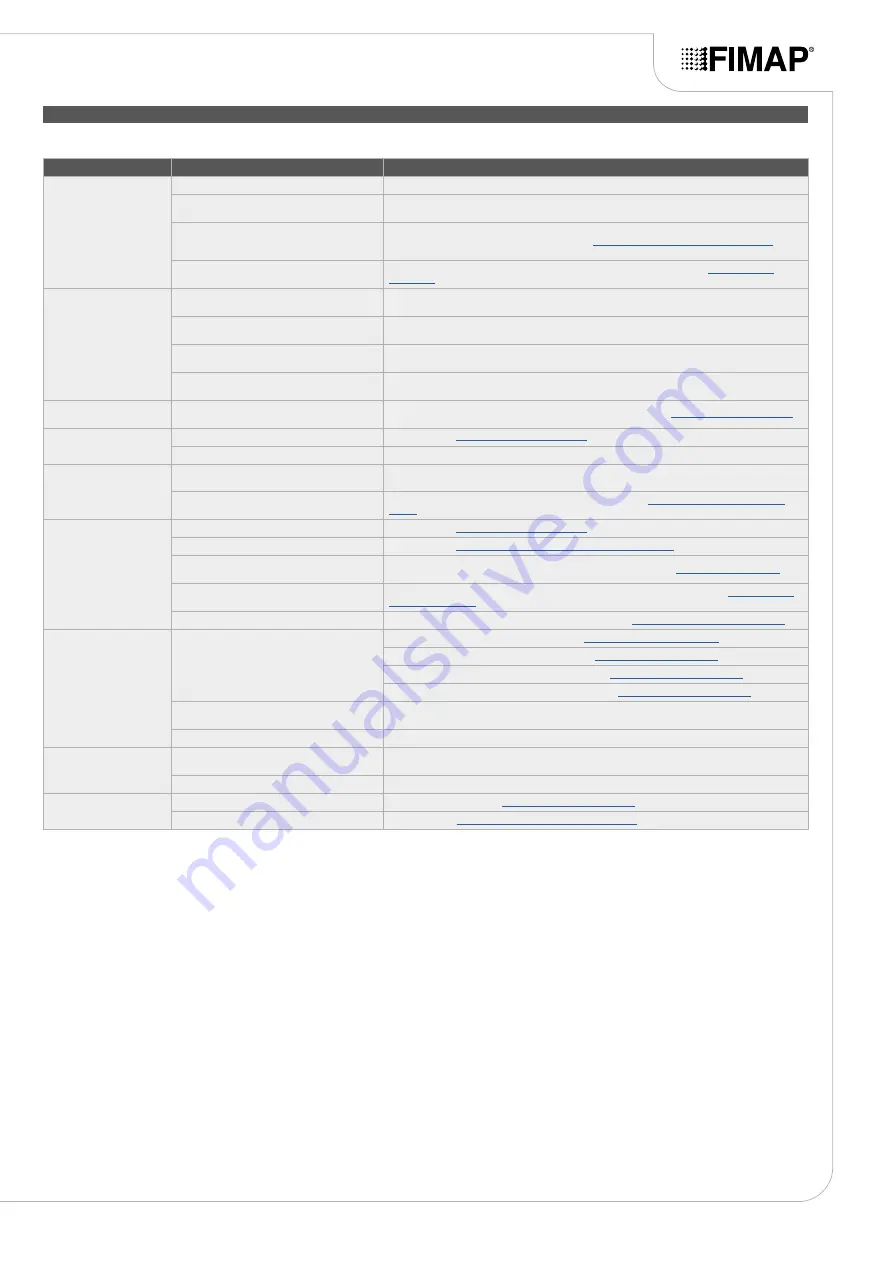
TROUBLESHOOTING
This chapter lists the most common problems linked with the use of the machine. If you are unable to resolve the problems with the information given here, please contact your nearest assistance centre.
21
PROBLEM
POSSIBLE CAUSE
SOLUTION
THE MACHINE DOES NOT
START
The main switch is set to “0”.
Make sure the main switch is on “I”. If it isn't, turn the key clockwise.
Check that, when switched on, there are no alarm
messages on the control display.
Stop the machine immediately and contact the technician of the specialised service centre, or press the SOS
button if the HFM kit is installed.
Make sure the batteries are correctly connected to
each other and that the battery connector is connected
to the electrical system connector.
Connect the batteries correctly inside the machine (see
INSERTING THE BATTERIES IN THE MACHINE
”).
Check the charge level of the batteries.
If the battery charge level is critical, perform a complete recharge cycle (see paragraph
CHARGING THE
BATTERIES
”).
THE BATTERIES ARE NOT
CHARGED CORRECTLY
(VERSIONS WITH BUILT-IN
BATTERY CHARGER)
The plug on the battery charger cable is not correctly
inserted in the socket on the battery charger itself.
Reconnect the battery charger power cable.
The plug on the battery charger power cable is not
correctly inserted in the electrical outlet.
Check that the battery charger power supply cable plug is connected to the mains socket.
The characteristics of the mains power supply do not
correspond to those required by the battery charger.
Check that the characteristics in the battery charger plate are the same as those of the mains supply.
The LEDs of the battery charger blink repeatedly.
Referring to the battery charger use and maintenance manual, check the meaning of the flashing signals that the
battery charger emits dung the battery recharge stage.
THE MACHINE HAS A VERY
LOW WORKING AUTONOMY
Check the battery charge level (check the symbol on
the control display).
If the battery charge level is critical, perform a complete recharge cycle (see "
”).
THE MACHINE DOES NOT
MOVE
The machine does not start.
”.
There is a drive pedal fault.
Contact your nearest service centre.
NOT ENOUGH DETERGENT
SOLUTION ON THE BRUSH
The quantity of detergent solution in the water system
is not sufficient for the work to be carried out.
Check that the amount of detergent solution present in the machine water system is sufficient for the work to be
carried out.
Detergent solution filter obstructed.
Check the detergent solution filter isn't obstructed. If it is, clean it (see “
OCLEANING THE WATER SYSTEM
FILTER
”).
THE MACHINE DOES NOT
CLEAN CORRECTLY
The machine does not start.
”.
Not enough detergent solution comes out.
NOT ENOUGH DETERGENT SOLUTION ON THE BRUSH
”.
The brushes have not been inserted correctly in the
machine.
Check that the disc brushes have been correctly inserted in the machine (see “
The type of brush used is not suitable for the dirt to
be removed.
Make sure the brushes fitted on the machine are suitable for the work to be carried out (see “
”.
The brush bristles are excessively worn.
Check the condition of the brush, and replace it if necessary (see “
REPLACING THE BRUSH HEAD BRUSH
”).
THE SQUEEGEE DOES NOT
DRY PERFECTLY
The vacuum unit is obstructed.
Make sure the squeegee is free of obstructions (see “
”).
Make sure the vacuum tube is free of obstructions (see “
Make sure the vacuum cap filter is free of obstructions (see “
”).
Make sure the vacuum motor filter is free of obstructions (see “
The cap on the recovery tank drainage tube is not
properly positioned.
Check that the cap on the recovery tank drainage tube is positioned properly.
The recovery tank lid is not positioned correctly.
Check that the recovery tank lid is properly positioned on the machine.
EXCESSIVE FOAM
PRODUCTION
The detergent being used is not suitable.
Check that a low foam detergent has been used. If necessary, add a small quantity of anti foam liquid to the
recovery tank.
The floor is not very dirty.
Dilute the detergent more.
THE MACHINE DOES NOT
VACUUM CORRECTLY
The recovery tank is full.
Empty the recovery tank (see “
”).
The vacuum device is obstructed
Read the section "




























